If you have a real Christmas tree, then you are in luck. There are lots of possibilities for it to have an extended life after the festive period. Here’s some ideas to help you out:
1. Plant your tree outside
Firstly if your tree has roots, then plant it out. Check the likely height and width it could become, and then choose a place where there is room for it to flourish and grow. In the photo above, the children were so pleased to see the Christmas tree in their outdoor space that before the end of the first day, cones and other natural ornaments adorned its branches once more.
At Tullos Nursery in Aberdeen, there has been a tradition of planting out each year’s Christmas tree. As a result, they now have a lovely woodland glade in their outdoor space.
2. Let your tree die beside a living specimen
This is a useful conversation piece as children can talk about what they see, notice and wonder about the changes taking place. It can take a very long time for some trees to shed their needles and truly degrade. It provides cover and dead foliage as well which sometimes schools and nurseries can be a bit too quick to remove.
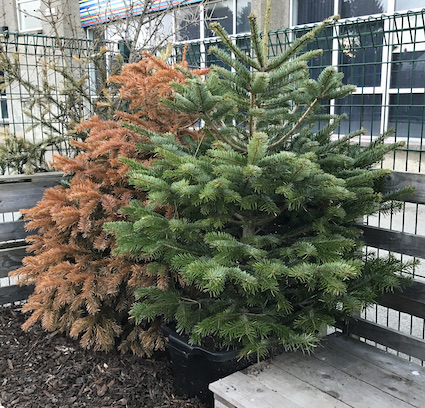
3.Use the bare tree for play and learning
Once you have stripped the needles off a tree then it can still be used. It can be moved around by children in their free play activities. Alternatively, hang a variety of items such as objects, numbers and letters onto its branches . It could even be redecorated in different ways!
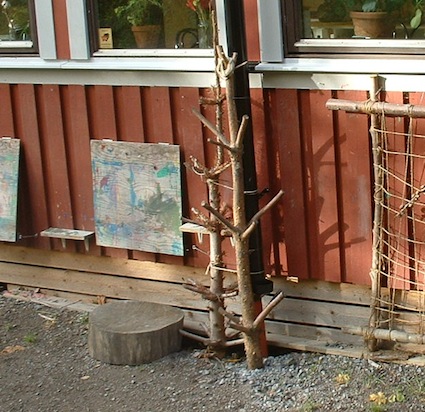
4. Use the brashings as a mulch
The brashings of Christmas trees make a decorative mulch as shown in the photo below. This was taken in April in Chicago and I thought it was a lovely functional way to use a tree and add different colour and texture to the beds.
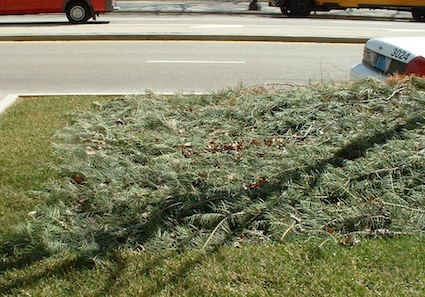
5. Compost the tree
This does take more effort. It involves chopping up a tree in to tiny pieces so that it can break down within a compost bin. However it’s great practice for children at using secateurs and even occasionally loppers, depending on the size of your tree and the amount of adult supervision needed. If you leave the tree until the needles are brown, then these can be stripped if you are wearing leather gloves and the leftover dry sticks used for kindling.
6. Use the brashings for wildlife habitats
The brashings of the trees can benefit wildlife. By leaving them in a pile with other dead material, then this can create a home for a variety of creatures, not least hedgehogs. A variation on this theme is the den in the above photo, from the Rosmarynek permaculture garden in Brno, Czech Republic. Here’s the cuttings and brashings are piled onto a wooden structure to create a den. Above the den, the brashings break down and climbing plants such as raspberries and blackberries are encouraged to grow over it.
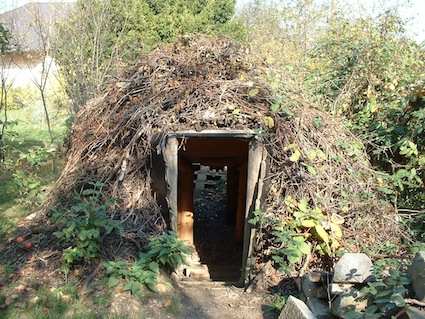
7. Den building with the brashings
Children can use Christmas tree brashings in their play. Dens can be made from the branches which have lost their needles or from fresh cuttings. In the photo below, the den was continuously maintained by the addition of conifer brashings which were lying on the forest floor. To make a free standing den, have a look at these instructions from the Forest School Association.

Below is a serious brashing den that was built up year on year by the children at this Swedish outdoor nursery… one lovely part of this that the den belonged to the children. Adults were only allowed inside if invited by a child!
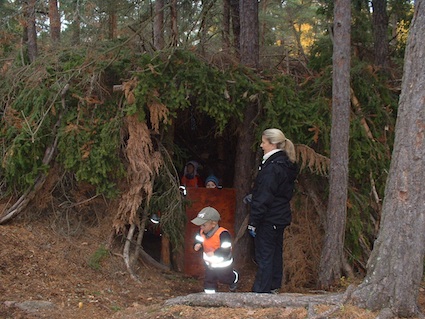
8. A bird-friendly recycled Christmas tree
Here’s a lovely blog post about how my friend, Andrea and her family re-used their Xmas tree. The process involved learning how to saw, dig a hole and make some bird feeders! It’s amazing. Furthermore the approaches to making bird feeders can be as inventive and creative as your children would like – with the follow up joy of seeing which design the birds seem to prefer or whether one species of bird prefers one design over another.
9. Just play with the brashings
- The smells and textures of different trees are amazing. Rub the needles and smell. Look at the bark and see if you can find any of the sticky runny sap. Use the fallen needles to make shapes, patterns to mark make with sticks in the ground, especially if a bed of needles suddenly drop.
- Depending on your tree type, it could be that you can chop up some of the pine needles very finely to make Scot’s Pine tea with a dash of honey.
- Little children enjoy the weight and movement of pulling around tree brashings. They can be used as big brushes for sweeping the ground. Some may want to try and make their own tails or fancy skirts!
Please suggest other possibilities for re-using Christmas trees – I’m sure there’s many more ideas out there! Whatever you decide to do, make the most of your tree and enjoy its extended potential for learning and play wherever you live
10. Feed the trees to your resident goats
Yes I know you probably don’t have goats at your school or nursery but it’s a great treat for them. I couldn’t resist adding in this video…
Should we be buying real Christmas trees?
The growing of Christmas trees is an intensive farming process. However, the carbon footprint of a real one remain significantly less than that of a plastic tree according to this article. A lot seems to depend upon how far you travel to source it and how you choose to dispose of it. If you can buy one with roots that can be planted then this is better. Best of all is simple to choose a tree that is already in your outdoor space and decorate this. There is also a growing trend for driftwood and other beautiful bare branches to be used as a Christmas tree decoration.
This post is a revamped version of the original first posted in 2013!




















Great ideas Juliet. I did get old branches for our muddy area last year & it was lovely, the smell was delicious every time it rained!
That’s a good idea – I never thought about it as a way of covering muddy paths, etc.
Thanks for great ideas Juliet. I second this use of trees for paths. We lay down the branches then put wood chip on top so it lasts much longer. If you put the wood chip directly onto the mud it just gets absorbed and churned up. We also took the opportunity to talk about how ancient people made walk ways (Sweet Track iron age road/path here in Somerset). Our groups really enjoyed having the sections of path they worked on named after them – we have Tom’s Way, Ashley’s Steps, Ryan’s Track…
oh Deb – that is a really clever idea! I know what you mean about the wood chip. Also like the idea of the path naming.
I use the old Christmas tree to feed my blueberries; I just chop the complete tree into small parts and then put in onto the soil by the blue berries. This helps keep the soil acid – which is what blueberries need.
That’s brilliant! Thanks so much for sharing this advice.
These are great ideas Juliet, I’m hoping to entice my children to create a den with ours. I’ll look forward to reading other suggestions too, thanks for linking up and sharing.
You’re welcome, Fiona – for those who don’t know, Fiona runs a family blog and every weekend hosts a link up which is full of outdoor activities. Have a look here: http://www.coombemill.com/blog/
Quick advice : Be sure to use a dustpan and broom or brush rather than a vacuum to clean up any needles that fall from the tree because they can clog the machine. (It also saves energy to do things by hand.) When preparing your tree for transport, don’t wrap it up in a plastic bag. Roll it in a blanket that you can later shake out and wash.
Ruth – thanks so much for this useful advice!